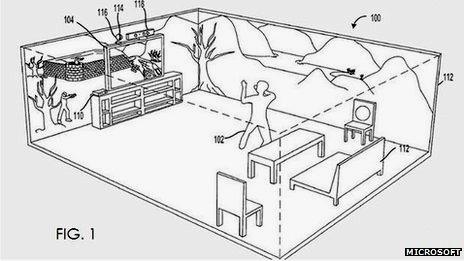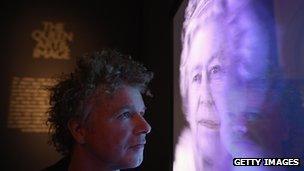Star Trek 'holodeck' in the living room?
- Published
Fighting fire in a virtual world
With "immersive media" taking content well beyond the TV screen, new technology is attempting to move virtual reality towards something even closer to real life.
Whether it be a cave, an igloo or a theatre, virtual reality is getting the immersive experience, with sight, sound and smell.
Full 360-degree screens are now capable of taking audiences to a whole new place. The companies pioneering this technology are hoping it will be close to a literal experience.
In a specially designed room, images are projected in every angle, even on to the ceiling so that those viewing are drawn into the illusion more fully than just looking at a screen.
Current applications are wide-ranging but include education about space travel, military training and acting as a tour guide around such sights as the pyramids. There is also a huge potential for gaming.
Flight simulators have offered a similar idea for a while but a true simulation cockpit costs about $20m (£13m) to purchase. It's still quite a way from the home for most.
"When it's done well it's an incredibly immersive experience, profoundly immersive," says Martin Howe, vice-president of tech company Global Immersion.
"It's like being there. In technology terms, it's just a giant computer... a super computer.
"We're just at the start... we can put anything on the screen."
But with screens already being the way a vast majority of people consume their information, what is so different about this?
'Suspend disbelief'
Visuals are wherever the person looks and even peripheral vision in a system like this is seen as incredibly important.
"Imagine if you went through the world with sight blinders on and could only see what's in front of you - how much of the world would you see?" says Mike Hancock, of Mechdyne which produces the Cave system.
"If you just have that flat screen, then you're blinding your peripheral vision so you don't get the information you would usually get, which your brain processes whether you know it or not."
The thinking behind bigger screens operating in every angle is to suspend disbelief for the time the people seeing it are there.
This would mean the psychological response is very similar to how it would be in real life.
"The minute they are in a situation where they have got visuals all around them, they feel like they are in that environment which is obviously far removed from just looking at a flat screen in a normal room," says Colin Yellowley, MD of Igloo Vision.
The Igloo is a steel-tubed framework covered in PVC and a 360-degree screen powered by five HD projectors.
It offers large-scale simulation and a screen that draws you into the experience because there is no chance to look away.
But people are still in a room without the ability to truly interact with their surroundings in a natural way?
Firefighters using the system for training use a joystick to look around the environment rather than physically moving through it.
But the benefits for them and other organisations using the devices are heralded as an important progression.
"What it does is it brings things into a more realistic perspective," says Neale Smiles, business director of military training company H4 Global.
"They can do things such as dangerous missions, bring things very close to your own position - all of the things that they are not allowed to do in peacetime using live munitions."
This is not just in vision. Military services have asked for smell and sound to play a key part in the training, from recreating the smell of vomit or blood to the noise of a helicopter landing close by.
It certainly is quite a way from a textbook and a white board.
Bullets 'around the room'
This technology is even creeping towards finding its way into the home. At the recent CES conference, Microsoft showed off a proof-of-concept video that expands games beyond the television screen.
Called the IllumiRoom, bullets fly through the room, environments appear off screen using projections and a Kinect motion sensor monitors the position of the user.

"[It] blur[s] the lines between on-screen content and the environment we live in allowing us to combine our virtual and physical worlds," wrote Microsoft., external
Rumours have emerged online that this could be somehow related to the new XBox console announcement. Microsoft will not say any more until further details emerge in April.
In other developments, the team behind Project Holodeck, dedicated to recreating the experience of virtual reality, have begun demonstrating devices they are working on., external
But can any of this really change the way most will watch content?

Holograms can be created already but not to the level where they are lifelike
"It did seem like a distraction," said IGN technology writer Melissa Grey.
"On video games forums, I asked whether people would use this and the overwhelming answer was 'no'.
"The human mind can only cope with so much visually before it starts to become overwhelmed.
"Immersive medias are the eventual big picture, but whether or not existing technologies are a stepping stone towards that, I don't know."
If immersive media is the big picture, how far can this technology go?
"Our vision is to build a holodeck one day," says Howe.
"It involves a number of technologies that don't exist yet so it's great - there's a lot of head room.
"It is a long way away but increasingly, that's the direction these technologies are heading in."
- Published7 November 2012
- Published12 September 2012